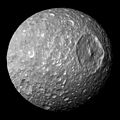File:Mimas Cassini.jpg

Size of dis one wey you fest dey see: 600 × 600 pizel-dem. Oda kwoliti-dem: 240 × 240 pizel-dem | 480 × 480 pizel-dem | 768 × 768 pizel-dem | 1,024 × 1,024 pizel-dem | 1,800 × 1,800 pizel-dem.
Orijina file (1,800 × 1,800 pixels, file size: 943 KB, MIME type: image/jpeg)
Tins wey don hapun for dis file
klik for eni date/time mek you see di file as e tek bi for dat time
| Date/Time | Smol smol imej | Damenshon-dem | Yuza | Koment | |
|---|---|---|---|---|---|
| di one wey dey nau | 19:51, 23 January 2011 |  | 1,800 × 1,800 (943 KB) | WolfmanSF | {{Information |Description ={{en|1=In this view captured by NASA's Cassini spacecraft on its closest-ever flyby of Saturn's moon Mimas, large Herschel Crater dominates Mimas, making the moon look like the Death Star in the movie "Star Wars." Herschel C |
| 03:36, 19 May 2010 |  | 2,000 × 2,000 (864 KB) | The High Fin Sperm Whale | {{Information |Description={{en|1=In this view captured by NASA's Cassini spacecraft on its closest-ever flyby of Saturn's moon Mimas, large Herschel Crater dominates Mimas, making the moon look like the Death Star in the movie "Star Wars." Herschel Crat |
How dem yuz di file
Dem dis pej dey yuz dis file:
How dem tek dey yuz dis file evriwie
Di oda wiki-dem dey yuz dis file:
- Dem yuz am for af.wikipedia.org
- Dem yuz am for am.wikipedia.org
- Dem yuz am for ar.wikipedia.org
- Dem yuz am for ary.wikipedia.org
- Dem yuz am for arz.wikipedia.org
- Dem yuz am for ast.wikipedia.org
- Dem yuz am for azb.wikipedia.org
- Dem yuz am for az.wikipedia.org
- Dem yuz am for ba.wikipedia.org
- Dem yuz am for be-tarask.wikipedia.org
- Dem yuz am for be.wikipedia.org
- Dem yuz am for bg.wikipedia.org
- Dem yuz am for bn.wikipedia.org
- Dem yuz am for bn.wikibooks.org
- Dem yuz am for br.wikipedia.org
- Dem yuz am for bs.wikipedia.org
- Dem yuz am for ca.wikipedia.org
- Dem yuz am for ckb.wikipedia.org
- Dem yuz am for crh.wikipedia.org
- Dem yuz am for cs.wikipedia.org
- Dem yuz am for cv.wikipedia.org
- Dem yuz am for cy.wikipedia.org
- Dem yuz am for da.wikipedia.org
Mek you see oda ples wey dem yuz dis file.





